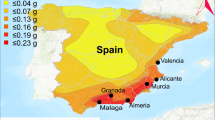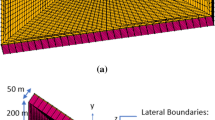Abstract
This paper first presents a critical review of the existing literature related to the seismic performance of river-crossing bridges considering scour effects. Two probabilistic models are proposed to answer the central research question—how to determine if a river-crossing bridge is seismic-scour critical. The two models, the mean-scour fragility analysis (MS-FA) and the total-scour demand hazard analysis (TS-DHA), produce operational analytics that enables comprehensive evaluation of seismic-scour effects. An integrated damage index is defined based on local and system-level ductility demands to accommodate a soil–foundation–structure bridge system with variable scour depths. The comprehensive numerical study illustrates that foundation scour tends to be beneficial by decreasing the probability of exceedance for minor or possibly moderate damage. Given the bridge model studied in this work, results obtained from the fragility analysis show a 2.5% decrease in the probability of exceedance of the moderate damage at the maximum considered earthquake level as scour depth (SD) increases from the levels of 10 m < SD ≤ 15 m to SD > 15 m. Also, the demand-hazard analysis illustrates the two-sided effects of foundation scour, which indicates that scour has a positive impact when the proposed damage index is smaller than 2.5 while having a detrimental effect as the damage index increases. This paper concludes with a verification of the proposed framework and remarks on choosing the proposed models in practice.






Similar content being viewed by others
References
Hunt BE (2009) Monitoring scour critical bridges: a synthesis of highway practice (NCHRP synthesis 396). Transportation Research Board
Wang X, Ji B, Ye A (2020) Seismic behavior of pile-group-supported bridges in liquefiable soils with crusts subjected to potential scour: insights from shake-table tests. J Geotech Geoenviron Eng 146(5):04020030
Ranjkesh SH, Asadi P, Hamadani AZ (2019) Seismic collapse assessment of deteriorating RC bridges under multiple hazards during their life-cycle. Bull Earthq Eng 17(9):5045–5072
Han Q et al (2019) Seismic response of single pylon cable-stayed bridge under scour effect. J Bridg Eng 24(6):05019007
Shang Y, Alipour A, Ye A (2018) Selection of input motion for seismic analysis of scoured pile-supported bridge with simplified models. J Struct Eng 144(8):04018099
Dong Y, Frangopol DM (2016) Probabilistic time-dependent multihazard life-cycle assessment and resilience of bridges considering climate change. J Perform Constr Facil 30(5):04016034
Federal Highway Administration (2018) National bridge inventory (NBI)
Rogers JD, Karadeniz D, Kaibel CK (2007) Seismic site response modeling for three Missouri river highway bridges. J Earthq Eng 11(3):400–424
McCullough M, Kareem A (2011) A framework for performance-based engineering in multi-hazard coastal environments. In: Structures congress 2011
Gill JC, Malamud BD (2014) Reviewing and visualizing the interactions of natural hazards. Rev Geophys 52(4):680–722
Arneson LA et al (2012) Evaluating scour at bridges: federal highway administration hydraulic engineering circular no. 18. Publication FHWA-IP-90-017
Briaud J-L, Gardoni P, Yao C (2013) Statistical, risk, and reliability analyses of bridge scour. J Geotech Geoenviron Eng 140(2):04013011
Bolduc LC, Gardoni P, Briaud J-L (2008) Probability of exceedance estimates for scour depth around bridge piers. J Geotech Geoenviron Eng 134(2):175–184
Briaud J-L et al (2007) Probability of scour depth exceedance owing to hydrologic uncertainty. Georisk 1(2):77–88
Alipour A, Shafei B, Shinozuka M (2012) Reliability-based calibration of load and resistance factors for design of RC bridges under multiple extreme events: scour and earthquake. J Bridg Eng 18(5):362–371
Avşar Ö, Atak B, Caner A (2017) In-depth investigation of seismic vulnerability of an aging river bridge exposed to scour. J Perform Constr Facil 31(5):04017044
Banerjee S, Ganesh Prasad G (2013) Seismic risk assessment of reinforced concrete bridges in flood-prone regions. Struct Infrastruct Eng 9(9):952–968
Chang K-C et al (2014) Seismic performance of an existing bridge with scoured caisson foundation. Earthq Eng Eng Vib 13(1):151–165
Feng C-W, Ju S-H, Huang H-Y (2015) Using a simple soil spring model and support vector machine to determine bridge scour depth and bridge safety. J Perform Constr Facil 30(4):04015088
Hong Y-M et al (2017) Multiphysics coupling model for computing pier scour upon simulation and experiment. J Comput Civ Eng 32(1):04017068
Johnson P et al (2015) Quantifying uncertainty and reliability in bridge scour estimations. J Hydraul Eng 141(7):04015013
Kameshwar S, Padgett JE (2018) Parameterized fragility assessment of bridges subjected to pier scour and vehicular loads. J Bridg Eng 23(7):04018044
Kong X, Cai C (2016) Scour effect on bridge and vehicle responses under bridge–vehicle–wave interaction. J Bridg Eng 21(4):04015083
Liao K-W, Chen W-L, Wu B-H (2017) Reliability-based design optimization of a river bridge considering uncertainty in scours. J Perform Constr Facil 32(1):04017118
Liao K-W, Muto Y, Gitomarsono J (2018) Reliability analysis of river bridge against scours and earthquakes. J Perform Constr Facil 32(3):04018017
Qi M, Li J, Chen Q (2018) Applicability analysis of pier-scour equations in the field: error analysis by rationalizing measurement data. J Hydraul Eng 144(8):04018050
Wang X, Ye A, Ji B (2019) Fragility-based sensitivity analysis on the seismic performance of pile-group-supported bridges in liquefiable ground undergoing scour potentials. Eng Struct 198:109427
Wang Z, Dueñas-Osorio L, Padgett JE (2014) Influence of scour effects on the seismic response of reinforced concrete bridges. Eng Struct 76:202–214
**ong W et al (2018) Vibration-based identification for the presence of scouring of cable-stayed bridges. J Aerosp Eng 31(2):04018007
Yilmaza T, Banerjee S (2018) Impact spectrum of flood hazard on seismic vulnerability of bridges. Struct Eng Mech 66(4):515–529
Zheng W, Yu W (2014) Probabilistic approach to assessing scoured bridge performance and associated uncertainties based on vibration measurements. J Bridg Eng 20(6):04014089
Zhu B, Frangopol DM (2016) Time-variant risk assessment of bridges with partially and fully closed lanes due to traffic loading and scour. J Bridg Eng 21(6):04016021
Badroddin M, Chen Z (2021) Lifetime resilience measurement of river-crossing bridges with scour countermeasures under multiple hazards. J Eng Mech 147(9):04021058
Badroddin M, Chen Z (2022) Lifetime resilience migration quantification using nonparametric distance metrics and application for river-crossing bridges. ASCE ASME J Risk Uncertain Eng Syst Part A Civ Eng 8(1):04021080
Wang Z, Padgett JE, Dueñas-Osorio L (2014) Risk-consistent calibration of load factors for the design of reinforced concrete bridges under the combined effects of earthquake and scour hazards. Eng Struct 79:86–95
Ghosn M, Moses F, Wang J (2004) NCHRP report 489: design of highway bridges for extreme events. Transportation Research Board, Washington, DC
Mylonakis G, Gazetas G (2000) Seismic soil-structure interaction: Beneficial or detrimental? J Earthq Eng 4(3):277–301
McGuire RK (1995) Probabilistic seismic hazard analysis and design earthquakes: closing the loop. Bull Seismol Soc Am 85(5):1275–1284
Field E (2005) Probabilistic seismic hazard analysis (PSHA): a primer. Available from: http://www.opensha.org/
USGS (2019) Seismic design maps & tools. Available from: https://earthquake.usgs.gov/hazards/designmaps
Kafali C, Grigoriu M (2007) Seismic fragility analysis: application to simple linear and nonlinear systems. Earthq Eng Struct Dynam 36(13):1885–1900
Brunner G (2019) HEC-RAS, river analysis system: hydraulic reference manual, version 5.0. 2016. Available online: https://www.hec.usace.army.mil/software/hec-ras/documentation/HEC-RAS, p 205
Shinozuka M et al (2000) Statistical analysis of fragility curves. J Eng Mech 126(12):1224–1231
Baker JW (2015) Efficient analytical fragility function fitting using dynamic structural analysis. Earthq Spectra 31(1):579–599
Bazzurro P, Cornell CA (1994) Seismic hazard analysis of nonlinear structures. I: methodology. J Struct Eng 120(11):3320–3344
Cornell CA et al (2002) Probabilistic basis for 2000 SAC federal emergency management agency steel moment frame guidelines. J Struct Eng 128(4):526–533
ACI (2014) Building code requirements for reinforced concrete. American Concrete Institute
Barbosa AR, Link T, Trejo D (2016) Seismic performance of high-strength steel RC bridge columns. J Bridg Eng 21(2):04015044
Rousakis TC (2018) Inherent seismic resilience of RC columns externally confined with nonbonded composite ropes. Compos B Eng 135:142–148
Tazarv M, Saiid Saiidi M (2016) Low-damage precast columns for accelerated bridge construction in high seismic zones. J Bridge Eng 21(3):04015056
Choi E, DesRoches R, Nielson B (2004) Seismic fragility of typical bridges in moderate seismic zones. Eng Struct 26(2):187–199
Kim S-H, Feng MQ (2003) Fragility analysis of bridges under ground motion with spatial variation. Int J Nonlinear Mech 38(5):705–721
Nielson BG (2005) Analytical fragility curves for highway bridges in moderate seismic zones. Georgia Institute of Technology
Alam MS, Bhuiyan MR, Billah AM (2012) Seismic fragility assessment of SMA-bar restrained multi-span continuous highway bridge isolated by different laminated rubber bearings in medium to strong seismic risk zones. Bull Earthq Eng 10(6):1885–1909
Park YJ, Ang AHS (1985) Mechanistic seismic damage model for reinforced concrete. J Struct Eng 111(4):722–739
Ghosh S, Datta D, Katakdhond AA (2011) Estimation of the Park–Ang damage index for planar multi-storey frames using equivalent single-degree systems. Eng Struct 33(9):2509–2524
Rajabi R, Barghi M, Rajabi R (2013) Investigation of Park–Ang damage index model for flexural behavior of reinforced concrete columns. Struct Design Tall Spec Build 22(17):1350–1358
Kunnath SK, Reinhorn AM, Park YJ (1990) Analytical modeling of inelastic seismic response of R/C structures. J Struct Eng 116(4):996–1017
Singhal A, Kiremidjian AS (1996) Method for probabilistic evaluation of seismic structural damage. J Struct Eng 122(12):1459–1467
Ghobarah A, Abou-Elfath H, Biddah A (1999) Response-based damage assessment of structures. Earthquake Eng Struct Dynam 28(1):79–104
Elenas A, Meskouris K (2001) Correlation study between seismic acceleration parameters and damage indices of structures. Eng Struct 23(6):698–704
Hindi RA, Sexsmith RG (2001) A proposed damage model for RC bridge columns under cyclic loading. Earthq Spectra 17(2):261–290
Park Y-J, Ang AH-S, Wen YK (1985) Seismic damage analysis of reinforced concrete buildings. J Struct Eng 111(4):740–757
Lee KH, Rosowsky DV (2006) Fragility analysis of woodframe buildings considering combined snow and earthquake loading. Struct Saf 28(3):289–303
Seyedi D et al (2010) Development of seismic fragility surfaces for reinforced concrete buildings by means of nonlinear time-history analysis. Earthq Eng Struct Dynam 39(1):91–108
Noh HY, Lallemant D, Kiremidjian AS (2015) Development of empirical and analytical fragility functions using kernel smoothing methods. Earthq Eng Struct Dynam 44(8):1163–1180
Caltrans (2019) Seismic design criteria. Version 2.0. Dept. of Transportation—State of California Sacramento, CA
Kobayashi MH et al (2012) Simple hydroelastic impact models for water-borne debris. Proc Inst Mech Eng Part M J Eng Mar Environ 226(2):170–179
Mazzoni S et al (2006) OpenSees command language manual. Pac Earthq Eng Res (PEER) Center 264:137–158
Guo X, Chen Z (2016) Lifecycle multihazard framework for assessing flood scour and earthquake effects on bridge failure. ASCE ASME J Risk Uncertain Eng Syst Part A Civ Eng 2(2):C4015004
NCHRP (2001) NCHRP project 12-49: comprehensive specification for the seismic design of bridges. National Cooperative Highway Research Program
PEER (2018) PEER ground motion database. Available from: http://peer.berkeley.edu/
Hwang H, Jernigan JB, Lin Y-W (2000) Evaluation of seismic damage to Memphis bridges and highway systems. J Bridg Eng 5(4):322–330
Kappos A, Paraskeva T, Sextos A (2005) Modal pushover analysis as a means for the seismic assessment of bridge structures. In: Proceedings of the 4th European workshop the seismic behaviour of irregular and complex structures, Thessaloniki, Greece
Paraskeva T, Kappos A, Sextos A (2006) Extension of modal pushover analysis to seismic assessment of bridges. Earthq Eng Struct Dynam 35(10):1269–1293
Park YJ, Reinhorn AM, Kunnath SK (1987) IDARC: inelastic damage analysis of reinforced concrete frame-shear-wall structures. National Center for Earthquake Engineering Research, Buffalo
Author information
Authors and Affiliations
Corresponding author
Ethics declarations
Conflict of interest
No author (M. Badroddin or Z. Chen) has a financial or personal relationship with a third party whose interest could be positively or negatively influenced by the article’s content.
Rights and permissions
Springer Nature or its licensor (e.g. a society or other partner) holds exclusive rights to this article under a publishing agreement with the author(s) or other rightsholder(s); author self-archiving of the accepted manuscript version of this article is solely governed by the terms of such publishing agreement and applicable law.
About this article
Cite this article
Badroddin, M., Chen, Z. Probabilistic Understanding of Seismic Performance of River-Crossing Bridges with Scour Effects: A Critical Review and Investigation of Seismic-Scour Damage Effects. Int J Civ Eng 21, 915–931 (2023). https://doi.org/10.1007/s40999-022-00794-1
Received:
Revised:
Accepted:
Published:
Issue Date:
DOI: https://doi.org/10.1007/s40999-022-00794-1




